One of the shots we see players struggling with the most is the backhand. That makes sense, it’s just not as easy to hit the ball leading with the back of your hand as it is the front of your hand.
So, I can understand why people have more trouble on the backhand side and that’s why today we’re going to go into five big mistakes that we see on the backhand side.
We can see these mistakes creeping in at all levels but these mistakes are found predominantly at the recreational level.
To be clear, we’re mainly talking about the one-handed backhand drive groundstroke but the same concepts apply to the one-handed backhand hit flat (no spin) or a backhand hit with topspin.
Before we dive into these mistakes, I want to clarify one non-negotiable that needs to be present on your one-handed backhand drive, and that is an in-front contact. You need to be sure to turn early enough to get your feet set well behind the ball, arrive in time and start your swing timed in such a way to get that contact well out in front.
On the forehand, although I don’t recommend hitting with a late contact, you can get away with it from time to time if you are desperate and use an alternate follow through that circles over your head. When it comes to the one-handed backhand however, it’s very difficult, in fact virtually impossible to pull of a late contact point. Alternate follow through options are just not biomechanically possible on that side.
If you’re going to be late to the shot you will most likely have to switch up to a slice which is one of the many reasons it’s good to have a backhand slice in your arsenal as well. A backhand slice does allow for a later contact than a drive.
So, it bears repeating that… when it comes to the backhand drive, if you want to have a strong one, you need to have that contact point well out in front. No exceptions!
Now that we have that squared away, let’s dive into the big mistakes I have for you and how to fix them.
Backhand Mistake #1 – “Slapping”
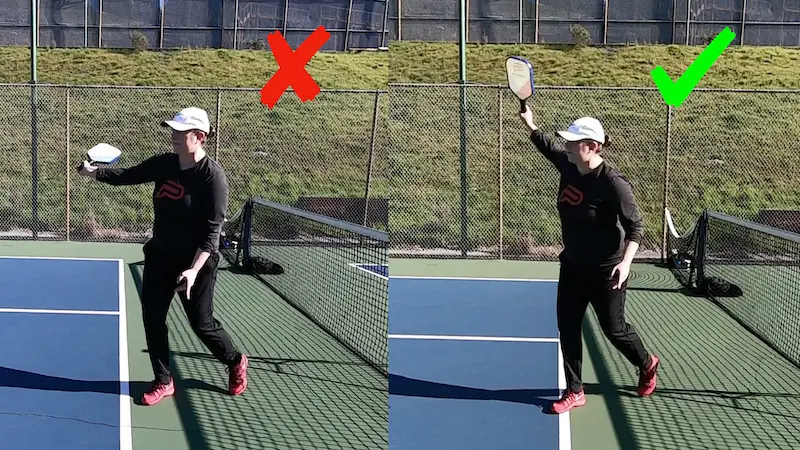
Mistake number is what I often refer to as “slapping”.
Basically, this is when you’re hitting your backhand and it looks just like a backhand slap. You’re using mostly your wrist/forearm and no body. You’re not letting the shot swing from your shoulder.
By doing this, you’re very limited in what you can do with the shot in terms of control, as well as power.
You really want to make sure to get a good strong shoulder turn. Get your hitting side shoulder all the way under your chin when you turn so that you can then uncoil into the shot. Start from your legs and use your whole body to hit that shot, and not just your wrist and forearm.
This is one of the key things you’re going to want to work on immediately if slapping is something that you do.
Backhand Mistake #2 – Separation of Arm From Body
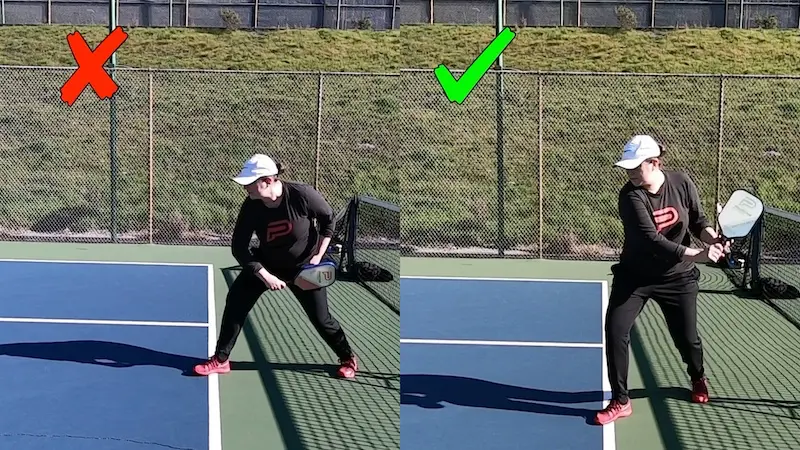
Mistake number two is having separation between your arm and your body.
I see symptoms of this problem popping up in various ways, such as: instead of your elbow pointing down it’s pointed forward, you might have your paddle down and against your body rather then set back and away from your body, you’re not turned enough and whatever else you may be be doing that is causing your arm to be away from your body.
You want your bicep really tucked up right against your body, your chin over your shoulder and your paddle high in the back so that you’re nice and coiled. You’re then going to use your uncoiling (from the ground) to swing that arm forward. It’s going to separate from your body heading into contact and you’ll finish nice and loose over to the off side.
You really need to learn to use your arm as a whip on your ground strokes, on both sides.
Here, we’re talking about the backhand, so you’re going to have your arm nice and tucked up against you so that you can turn and uncoil and whip it around.
That’s what’s really going to allow you to have a powerful backhand that you can ramp up or ramp down in speed, as you wish, simply by controlling your uncoil. So, be sure to get that arm tucked up against your body as you’re turning and preparing for that backhand.
Backhand Mistake #3 – Not Enough Paddle Head Drop
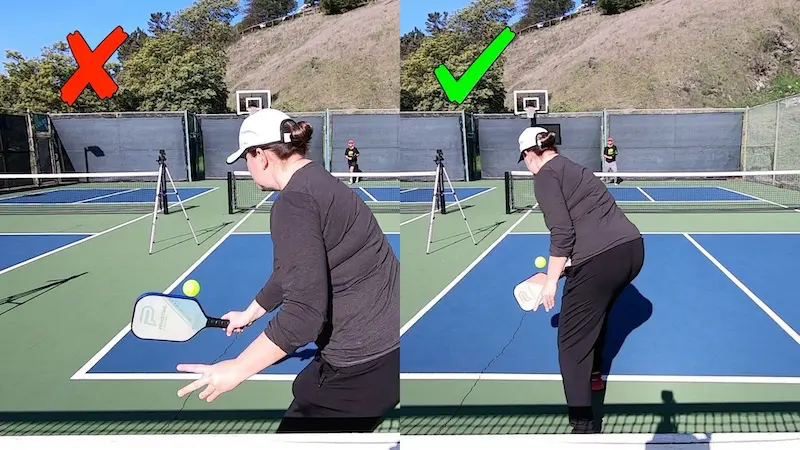
Mistake number three is not dropping your paddle head enough as you come into contact.
You want to start with your paddle tip up when you take your paddle back to initiate the shot, then you want to let it tip down and get under the ball before contact and then come up and through your shot.
Now, depending on how flat you want to hit it or with how much topspin you want to hit it, you’ll come down a bit more or a bit less. You’ll get down further if you’re going to hit some more topspin and a bit less if you’re going to drive it flat.
And remember, you’re always fighting gravity a little bit and you do need to typically hit somewhat up on the shot at virtually all times and on all shots to compensate for that.
In pickleball, the ball doesn’t bounce very high, and this in combination with needing to fight against gravity somewhat with each shot is another reason why you need to focus on being sure you are getting that paddle head under the ball most of the time on groundstrokes or it’s often going to go into the net.
Thinking in terms of efficiency and effectiveness of the execution of your shot and use of your body, you want to let your wrist drop down in order to let that paddle head drop under the ball.
This will allow you to activate and access your forearm and release it into the shot so you can get a little bit of leverage and extra pop into the shot. It makes a big difference. If you don’t allow this to happen you miss out on the extra pop in terms of speed or spin on the shot making it less effective than it could have been.
Notice how I said “allow”. You need to let your wrist drop down rather than force it. This is true for all part of the shot. You need to “allow” more than “do”.
You need to really be able to let your arm fly from the beginning and all the way through the very end of the shot and this can all only happen if you are relaxed throughout the shot and “letting” your body do the work rather than forcing it through these checkpoints. It takes practice and repetition to get the hang of this.
So, start with your tip up, let the paddle head drop under, and then come through and finish around.
Another issue that often comes up if you don’t drop your paddle head down enough is that you’re going to have a tendency to come across the ball with an outside to inside motion and end up hitting side spin when you didn’t mean to. If you notice unintentional side spin on your shots, it probably means that you’re not dropping your paddle head down enough.
Not dropping the paddle head enough coming into contact is a very common problem on the backhand side and I see it being overlooked often. You’ll definitely want to take a look at this see if you’re doing it and clean it up if you are. Your sacrificing an awesome backhand if you don’t address this!
Backhand Mistake #4 – Incorrect Use of Non-Dominant Arm
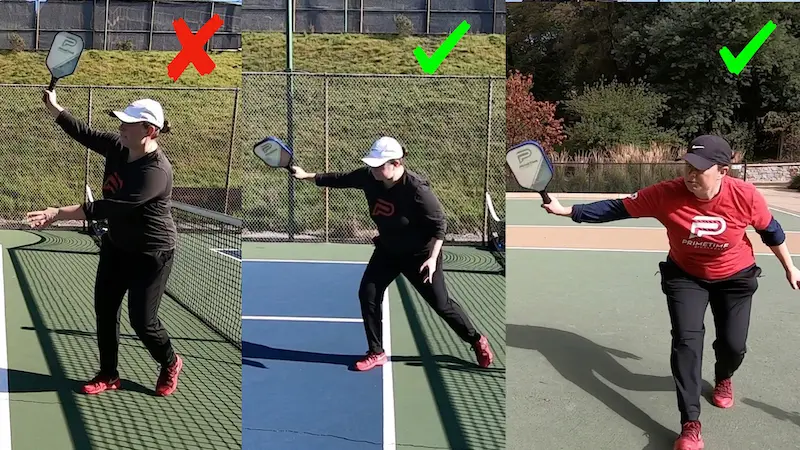
Mistake number four is not using your non-dominant arm correctly.
First and foremost, it is helpful to use your non-dominant hand as you set the paddle back, particularly on your one-handed backhand groundstroke.
You want to have that off hand there to help you really get nice and turned for the set. And then, in addition to that, when you drop into the swing and you’re coming through, you want to send that non-dominant arm back acting as a counterbalance so that it can really let your dominant hitting arm fly through the shot.
If you let the two come through together, your dominant arm is not going to be able to travel at top speed which will significantly reduce your power potential.
Depending on how much you’re wanting to let your arm fly on any particular backhand, you’re gonna need a little bit more or a little bit less of a counterbalance. Use your non-dominant hand and arm to set the paddle at the beginning of the stroke and then use it as a counter bounce during the swing to control the power you want on any given shot.
If you watch really good players with a strong one handed backhand, you’ll see that across the board they’re using their non-dominant arm effectively to help them hit the best shot possible given the situation. You can’t achieve maximum speed if you don’t do this correctly.
Backhand Mistake #5 – Pulling Your Eyes Off Contact Too Soon
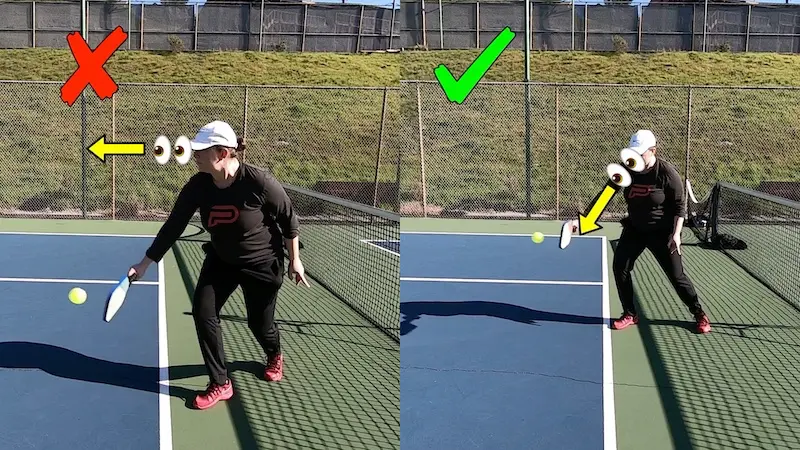
Lastly, we have mistake number five which is pulling your eyes off of contact too soon.
This is a very common mistake in general on all shots. Players rush to look at where their ball is going as opposed to really completing their shot.
If you lift up your head too soon it pulls up your torso and brings your swing up a little bit higher than you meant too. This can cause you to sail the ball longer than you intended. You’re also increasing the opportunity and likelihood of having shaky off-center, off-the-sweet spot, contacts.
You really want to commit to keeping your eyes on the ball just a fraction longer. It will feel like a long time, but it’s really not that much.
Keep that chin down, the eyes on contact and as much as possible through contact, before you pull up to look over to the other side and finish your shot. I see this problem so very often, you really want to keep those eyes down a bit longer which will help stabilize your entire shot.
By doing this you will hit much better backhands, much more consistently, as a result. The court is not moving, the ball is moving, so keep your head down and your eyes on that contact longer. This will really help your shot.
Final Thoughts
These five backhand mistakes are certainly not the only mistakes that could be made on the backhand side but they are five very big ones.
So, if you see yourself in any one of these mistakes you’ll want to take steps to correct that immediately. Your backhand will jump to an entirely new level and be unrecognizable compared to what it is now.
You’ll be a much happier and better player and the chances of that resulting in more wins is high.